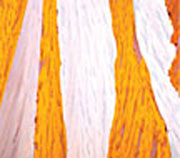- Number 300 |
- November 23, 2009
Rethinking organic electronics

Engineered organic semiconductor
crystals such as these could be
useful in digital displays and
flexible electronics.
A team of engineers has explained a frustrating inconsistency in the performance of electronics made with organic materials, using data taken at the Stanford Synchrotron Radiation Lightsource, located at DOE's SLAC National Accelerator Laboratory.
The research, which shows that the way boundaries between individual crystals in a film are aligned can make a 70-fold difference in how easily electrical charges can move through transistors, could help engineers design better digital displays and other devices.
Organic semiconductors have a lot to offer in electronics. They are cheap and flexible, and the production process is much simpler than for traditional silicon chips. Applications such as computer display screens, digital signs or magazines made of "electronic paper" have been possibilities for more than a decade, but their full potential seems always just around the corner.
The researchers found that the "grain" boundaries between crystals can become misaligned, making the path that electric charges must follow through a transistor look more like a disjointed slog than a sprinter's dash. By growing crystals of an organic semiconductor using a process that ensures consistent alignment from crystal to crystal in a particular direction, the researchers created transistors that performed far better.
The study's lead author, Stanford University graduate student Jonathan Rivnay, said the team's work could strongly influence how organic crystal electronics are made in the future.[Melinda Lee, 650.926.8547,
melinda.lee@slac.stanford.edu]
